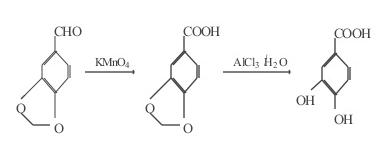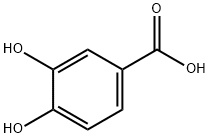Protocatechuic acid (3,4-dihydroxybenzoic acid, PCA) is a simple phenolic acid. It is found in a large variety of edible plants and possesses various pharmacological activities.
Protocatechuic acid has an antibacterial effect, and has different degrees of antibacterial effect on Pseudomonas aeruginosa, Escherichia coli, Typhoid bacillus, Shigella, Alcaligenes, Bacillus subtilis and Staphylococcus aureus in vitro. It also has expectorant and anti-asthmatic effects. It is clinically used to treat chronic bronchitis.
Protocatechuic acid has a density of 1.54g/cm3 and a melting point of about 200°C. It is soluble in ethanol, ether, acetone, ethyl acetate, soluble in hot water, slightly soluble in cold water, and insoluble in benzene and chloroform. Decomposes in boiling water and emits carbon dioxide. Its aqueous solution is green when it meets ferric chloride, and red when it meets sodium bicarbonate. It is a white to brown crystalline powder that will change color in the air.
Pharmaceutical Applications
Protocatechuic acid is a metabolite of complex polyphenols, such as anthocyanins and proanthocyanidins. They are high in plants and fruits and can be absorbed by animals and humans. It is estimated that people’s daily intake of anthocyanins is higher than other anthocyanins. Polyphenols are higher, so the nutritional value of protocatechuic acid is increasingly recognized. A large number of experiments have proved that protocatechuic acid has a variety of biological activities against different molecular targets. It has antibacterial, antioxidant, anti-inflammatory, anti-hyperglycemic and neuroprotective effects. In addition, protocatechin has potential chemical Protective effect, it can inhibit chemical carcinogens in vitro and produce pro-apoptosis and anti-proliferation effects in different aspects.

1.Preparation of piperonic acidAdd 12 g piperonal and 300 ml water into a 1000 ml three-necked flask, heat it to 70~80℃, and under vigorous stirring, add 5% potassium permanganate aqueous solution (18 g potassium permanganate plus 360 ml Water), the dripping time is about 30 minutes, after the addition, continue to stir until the purple fades, filter while hot, and wash the filter cake. The mother liquor is acidified and filtered to obtain piperonic acid. The finished product is naturally dried 12.4 g, the yield is 94%, and the melting point is 228~231℃.2. Preparation of protocatechuic acidAdd 4 g of aluminum trichloride to 150 ml of nitrobenzene, stir to dissolve, add 10 g of piperonic acid in batches, stir at room temperature for 3 to 5 h, pour the reaction solution into 100 ml of water, separate the water layer, Sulfur dioxide was introduced into the aqueous solution, and protocatechuic acid was precipitated. The dry weight is 7.5g, the melting point is 200~201℃, and the yield is 81%.
white to light yellow crystal powder
3,4-Dihydroxybenzoic acid is a metabolite of polyphenols such as phloretin and quercetin. It is also a phenolic acid antioxidant present in fruits, vegetables and nuts. Further, it is found to be an efficacious chemopreventive agent in several carcinogenesis models. In addition to this, it acts as an anti-inflammatory agent.
A phenolic acid antioxidant and chemopreventive agent
3,4-Dihydroxybenzoic Acid is a metabolite of polyphenols such as Phloretin (P339000) and Quercetin (Q509500).
ChEBI: A dihydroxybenzoic acid in which the hydroxy groups are located at positions 3 and 4.
Protocatechuic acid is synthesized from the intermediates of the shikimate pathway. In this case, 3-dehydroshikimate is converted to protocatechuic acid as shown in Fig.11.2. Activity measurements from mung bean seedlings, on the other hand, indicate that 3-dehydroshikimate can be converted to protocatechuic acid (Widhalm and Dudareva 2015). Protocatechuic acid (11.12) upon hydroxylation produces gal- lic acid. The enzyme catalyzing this reaction is not well understood (Muir et al.2011).

Biosynthesis of Protocatechuic Acid
Protocatechuic acid belongs to the class of polyphenolic compounds, which can be generally isolated from the dried flower of roselle. It can serve as a potential candidate possessing anticancer property, which can be involved in suppressing the growth of human promyelocytic leukemia HL-60 cells.
Protocatechuic acid (PCA) is a dihydroxybenzoic acid phenolic compound found in many edible and medicinal plants. It is a major metabolite of antioxidant polyphenols found in green tea and demonstrates free radical scavenging capability in a 1,1-diphenyl-2-picrylhydrazyl radical scavenging activity assay (IC50 = 16.3 μM). It is thought to possess anti-inflammatory, antihyperglycemic, neuroprotective, and anticancer activities. Dietary administration of PCA dose dependently inhibits in vitro chemical carcinogenesis and exerts pro-apoptotic and anti-proliferative effects in different tissues. In studies of tumor cell migration and invasion using mouse melanoma B16/F10 cells, PCA at 0.1-2 mM down-regulated the Ras/Akt/NF-κB pathway by targeting RhoB activation, leading to a reduction of MMP-mediated activity.
Chemopreventive in several animal models of carcinogenesis. Blocks cell proliferation in the post-initiation phase.
Protocatechuic acid, in free or bound form, is found in the leaves, fruits, wood, barks, flowers of many angiosperms. Free protocatechuic acid is found in the scales of onion (Allium cepa L.), star anise fruits (Illicium L.) and leaves of grapevines (Vitis L.). It is part of the tannins from leaves of apple trees, bark of oak, bark and flowers of acacia (Acacia L). The 3,4-dimethyl ether of protocatechuic acid, the socalled veratric acid, is widely distributed.





